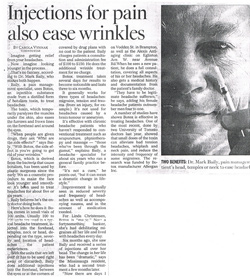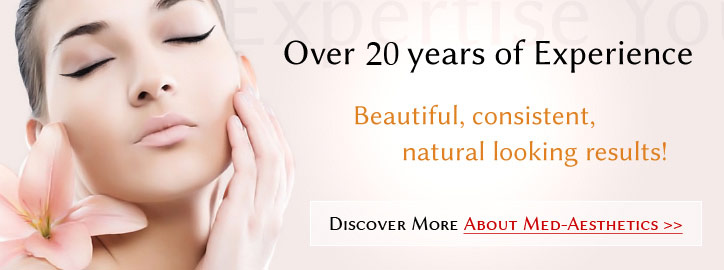Injections for pain also ease wrinkles; Small doses of Botox bring relief

Imagine getting relief from your headaches.
Now imagine looking younger in the process.
That’s no fantasy, according to Dr. Mark Baily, who makes both happen.
Baily, a pain management specialist, uses Botox, an injectible substance made from a distilled form of botulism toxin, to treat headaches.
The toxin, which temporarily paralyzes the muscles under the skin, also eases the furrows and frown lines on the forehead and around the eyes.
“When people are given drugs, they ask ‘What are the side effects?’ ” says Baily. “With Botox, the side effect is you’re going to get rid of your wrinkles.”
Botox, which is derived from the bacteria that cause botulism, has been used by plastic surgeons since the early ’90s as a cosmetic procedure to make the face look younger and smoother. It’s been used to treat headaches for about five or six years.
Baily believes he’s the only doctor doing both.
Here’s how he does it: Botox comes in small vials of 100 units. Usually 100 to 200 units are used in a typical headache treatment, injected into the forehead, temples, neck or head, depending on the type, severity and location of headaches the patient experiences.
With the units that are left over (it has to be used right away or discarded), Baily does additional injections into the forehead, between the eyes or at the corners of the eyes. This smoothes out the crow’s feet and lines in the upper part of the face. It’s not used around the mouth because the muscle paralysis would affect a person’s smile.
There is some overlap between the two applications (for headaches and cosmetic purposes) because “when we do headaches, we typically do the forehead but not usually crow’s feet.”
A cosmetic procedure of this sort normally costs between $400 and $600. But when Botox is used as a medical treatment, it’s often covered by drug plans with no cost to the patient. Baily charges patients a consultation and administration fee of $100 to $150. He does the additional wrinkle treatment for no charge.
Botox treatment takes several days for results to become noticeable and lasts three to six months.
It generally works for three types of headaches: migraine, tension and trauma (from an injury, for example.) It’s not used for headaches caused by a brain tumour or aneurysm.
It’s effective with chronic headache patients who haven’t responded to conventional treatment such as acupuncture, physiotherapy and massage- “those who’ve been through the gamut,” explains Baily, a headache specialist for about six years who ran a general family practice before.
“It’s not a cure,” he points out, “but it can mean a dramatic change in lifestyle.”
Improvement is usually seen in reduced severity and frequency of headaches as well as accompanying nausea, and in the amount of medication needed.
For Linda Christensen, Botox is “magic.” Now a fortysomething banker, she’s had debilitating migraines all her life and lived with headaches every day.
Six months ago, she saw Baily and received a series of injections all over her head. The change in her life has been “dramatic,” says the Mississauga resident, who had a second treatment a few months later.
“Now there are days I wake up and nothing hurts. The degree and frequency of my headaches have diminished 50 to 60 per cent.”
An added bonus is her wrinkle-free forehead: “It’s like a baby’s bum, it’s so smooth.”
According to Baily, it’s unclear how Botox works on headaches but in addition to relaxing or paralyzing the muscles, it appears to block the release of chemicals that cause headaches.
Baily works out of the Headache Treatment Clinic on Main St. in Toronto and on Vodden St. in Brampton, as well as the Alexis Anti- aging clinic on Eglinton Ave. W. near Avenue Rd.When he sees a new patient, he does a full consultation, covering all aspects of his or her headaches. He also gets a medical history and documentation from the patient’s family doctor.
“They have to be legitimate headache sufferers,” he says, adding his female headache patients outnumber men four to one.
A number of studies have shown Botox is effective in treating headaches. One of the most recent, done by two University of Toronto doctors last year, showed that small doses of the toxin can alleviate bad tension headaches, whiplash and neck pain, and reduce the intensity and frequency of some migraines. The research was funded by Botox manufacturer Allergan Inc.






